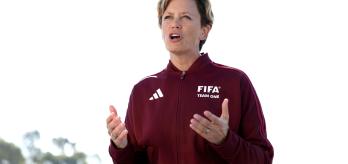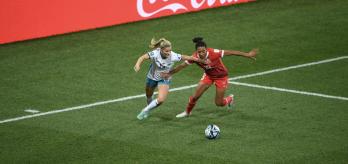FIFA's collaboration with experts like Ric Lovell (Associate Professor University of Wollongong, Exercise Science, Wollongong, Australia) and Georgie Bruinvels (Research Associate, St Mary’s University, Twickenham, London UK), along with Scott herself, underscores the dedication to enhancing women's football through tailored training programmes and research initiatives, such as the Female Health Project and Women’s National Team Preparation Programme. These pilot initiatives are designed to support the education and implementation of evidence-based strategies to support the development and preparation of female players.
Drawing from her analysis of physical data from the FIFA Women’s World Cup Australia and New Zealand 2023™, Scott provides valuable insights into the evolving trends in female football performance across recent World Cup cycles. Central to her analysis are the speed zone thresholds, standardised based on research by Scott and colleagues (Park et al., 2018), which delineate distinct levels of speed within the game. Scott highlights the variability of speed zones in women's football, underscoring the necessity for a standardised framework to facilitate meaningful comparisons across studies and research endeavours. Additionally, she acknowledges the multitude of factors influencing the interpretation of physical data, including monitoring systems, tracking technology, playing surfaces, environmental conditions, and regulatory shifts within the sport.
This article delves into Dawn Scott's analysis, illuminating the complexities of women's football performance and support informed strategies to elevate the sport to new heights.
Data collection and analysis
-
Data collection: 3-camera system
-
Analysis process: advisor group
-
Tournament comparison: 2007 and 2011 (match duration only), 2015, 2019 and 2023
-
Team totals: all outfield players who entered the field of play, 90+min only
-
Positional comparisons: Goalkeeper (GK), Wide defender (WD), central defender (CD), central midfielder (CM), wide midfielder (wm), forward (FWD), 90+min only
-
Case study: AUS, ENG, ESP and SWE
-
Speed zone thresholds used: See image below
-
Special thanks to the following for their contribution to this analysis and interpretation: Dr Dean Norris, Associate Professor Richard Lovell, Belinda Wilson, Gemma Grainger, Dr Blanca Romero, Tom Gardner, Harry Lowe.
Match duration comparisons
Looking back as far as 2007, the match duration in women’s World Cups has steadily increased, yet interestingly, the actual playing time has remained relatively stable. The average match duration in 2015 increased from 95:02 to 97:43 (2019) to 102:24 (2023) with the introduction of VAR as the key contributory factor. However, the actual playing time in 2023 (56:54) was similar to that seen in 2011 (56:21), albeit up slightly from 2019 (54:41).
According to Scott, “When we look at the jump in game time from 2015 to 2023 (+7:22 mm:ss) we can see that this is likely a result of more stoppages in the game, as the percentage of actual playing time has remained stable. However, if you are preparing players for over 100 minutes of match play, there are physical and mental demands that coaches need to consider in their preparation and recovery protocols, especially when those match lengths must be repeated throughout a tournament.”
Speed zone comparisons
One of the most notable observations from 2015 to 2019 was the increase in total distance covered by teams and more particularly the volume of higher speed running (SZ45). However, these distances levelled off somewhat in 2023, despite the increase in match duration. According to Scott, the trends relating to speed zone 3 (13-19km) over the past three tournaments are interesting, and this type of distance, and how it is achieved, is often neglected in the physical preparation of players.
“The professionalisation of teams and players within the women’s game, I feel, is a big factor in the large increases in distances covered in SZ45 we saw from 2015 to 2019 and these were always likely to level off, but distance covered in SZ3 has continued to increase. This running is often recovery-type running, so players getting back into position and this type of running really needs to be factored into weekly training loads and considered because the game is faster, they must get back into position quicker, restarts happen quicker, so running volume in this zone is perhaps now important too.
“A lot of times we focus on high intensity training and low intensity volumes, but we need to pay attention to this mid-range zone (SZ3), especially when we see the distances covered at this intensity increasing so significantly again. An example of the in-game running completed in this speed zone could be a player’s recovery back into position after a high intensity burst forward and this comes from increased tactical responsibilities. This trend is replicated across teams in the tournament, not just the four semi-finalists so this is a speed threshold that we need to think about.
“In addition, there is notable disparity between the distances covered by different teams, this also can be reflective of where they are in their development or the tactical approach. When we sum the total distances covered by all outfield players in a team in each game, there are differences of up 30km which is quite a lot because that’s approximately 3km on average per outfield player. Similarly, when we look at SZ45 the variation was 5km, an average of 500m per ten outfield players. And when we look at those variances across positions, the range is 4km in total distance and 1600m in SZ45.”
TEAM CASE STUDY: Spain, England, Sweden, Australia
Before delving into the 2023 case study, it is important to recognise the significant increases in total distance covered by teams in the 2019 Women’s World Cup when compared to 2015. We can see in the graphic below how strong this shift was in the distance covered by players when covering distances in SZ45 (speed zones 4 and 5 combined). In 2023, Australia, England and Sweden did not complete major increases in distance covered in this threshold (Australia and England registered slight declines), however World Cup winners, Spain, recorded another significant rise in their distance covered at the higher speeds, although it should be noted that their baseline point in 2015 (prior to having a professionalisation of the women’s domestic league in Spain and training full-time) was much lower than the other three teams. In addition, Spain’s finishing positions in the three consecutive World Cups possibly has an association with the increases in their physical outputs with a group stage finish in 2015, Round of 16 in 2019 and winners in 2023.
For Scott, the trends are complex and should be interpreted with caution. “It is also important to contextualise the type of running that teams are doing in games and recognise that some decreases can be down to tactical or strategic changes or can be reflective of the scores in games and their relevance to the team’s position in the tournament. It’s not the case that running more is an indicator of success, the type of running and the reason for it must be considered,” she added.
Positional comparisons
In terms of preparing the players to compete and perform, the positional demands of their role within the team must be factored in when determining the components of their training loads.
According to Scott, “Even the player’s role within the position must be considered when planning training sessions and player loads. For example, the role of a false 9 is very different to that of a more traditional 9, and even in the World Cup we saw that players had different roles for their teams in different games, based on their opponents and game strategies.
“Georgia Stanway played different roles for England, while Lauren Hemp played as a forward but operated both centrally and wide, so it’s about understanding the different match demands that different roles and positions can have on a player’s physical output and it’s really important to understand that. How and when a team presses and time spent in and out of possession can also have an impact on the physical match demands so all these components relating to game strategy and player roles are important when analysing and benchmarking physical performance,” she explained.
In addition, individual female health considerations such as the type of cycle, specific menstrual cycle phase, fatigue and the player’s recovery status should also be factored in by the sport science team and coaches when planning training loads, in addition to knowing and understanding the characteristics of the women’s game.
PHYSICAL OUTPUT WHEN PRESSING
When we explore the outputs of teams when pressing, the context is crucial. Knowing how, when and why they pressed must be considered in addition to how much time they spent without the ball. Understanding the proportion of their time they spent in different defensive phases highlights the different approaches and capacities of teams.
As we see in figure 9 below, Spain were the lowest ranked team for the number of presses exerted in a low block. Their output (distance covered in SZ45) increased when in mid press and was highest when in high press, however of all teams in the competition, they spent the lowest time without the ball. In contrast, China pressed the most when in low block and the least when in high press, demonstrating their different approaches to pressing when out of possession.
In figure 10, we can see how the stage of the competition impacted on pressing outputs and strategies. Germany and Spain clocked their lowest distance when pressing during the group stages (per 90+mins).
CASE STUDY - THE FINALISTS: England and Spain
When we delve deeper into the individual games that both finalists, England and Spain, played enroute to the final, we gain greater context and understanding of their respective tournament journeys.
Changes in team formation, the way the opposition sets up, the stage of the tournament, squad rotation and the cumulative loads, can all impact the physical outputs in any one game, so while looking at averages can give interesting insights, it is important to explore what happened game to game.
As Scott explains, “As we see in the figure below, England’s highest total distance was in their third group stage match, a 6-1 victory over China, where they changed formation, but then they recorded their lowest total distance of the tournament in the following game against Nigeria. Their SZ45 distances dropped after game one and only peaked again for the semi-final and final, again this can be attributed to changes in formations and the impact of how their opponents were set up. When we look at the counts of their full press, they see-sawed from game to game, but peaked in the final against Spain, when their opponent dominated possession of the ball. In addition, we can see in figure 7 how player loads changed and compared from game to game based on changes in their positions, game time and roles within their positions. Lauren Hemp is an example of this, sometimes she played wide, sometimes as the 9 (centre-forward) and Georgia Stanway played some games as the holding/defensive midfielder and others as the 8 (box-to-box midfielder).
“When we look at Spain’s tournament journey, their highest total distance covered and SZ45 distances were recorded in their second group-stage match against Zambia but in their third and final group match (when already guaranteed progression and having recorded very high SZ45 distances in their first two matches) they recorded their lowest outputs in their surprise 4-0 defeat to Japan. So again, the context of the cumulative loads, squad rotations, game plans, opposition strategy etc... has to be factored in when analysing the numbers. And as we can see, after the Japan game, Spain’s SZ45 distances steadily increased game by game for the remainder of the tournament,” she added. Spain also dominated possession in their games, so this is where the in possession and out of possession speed zone loads will be different for different teams and that must be factored in to training planning,” she added.
THIRD AND FOURTH PLACED: Sweden and Australia
Using the same contexts, similar reflections can be noted when analysing the physical outputs of Sweden and Australia. For example, when we look at Sweden’s full press count in their first game against South Africa (graphic 15), we can see it is far below their average for their remaining six games, but this is because they really dominated possession in this match. Their second lowest count was registered versus Argentina, when once again, they dominated the ball.
Scott explains, “Similarly, when we look at Australia, they had steady progression from game one to game two and then had their highest output during the tournament against Canada, in what was a must-win game in order for them to progress from the group stage. Again, the context of the game matters but also the positional demands and the physical capabilities of the player. For example, in figure 17, we see Steph Catley (AUS) played every minute of every game and she was among her team’s top physical outputs in every game.”
SUMMARY
When considering the physical outputs and training loads of teams, and of the players within the teams, context is key. Match duration, in-play time and playing minutes are all important factors when periodising team training. Match demands on individual players vary from game to game depending on their position and the specific role responsibilities required depending on the game strategy.
Tactics, opposition set-up, styles of play and stage of the tournament are also relevant when devising training sessions and recovery, in addition to the physical capacities of the players. Once all these components are factored in, the total distances covered by teams in games, and the distances covered across the various speed zones (both as a team and as individuals) can be analysed with the context they require. Modern tracking technologies and data analytics can be invaluable here, allowing coaching staff to monitor outputs precisely and adjust training loads effectively. This could involve reducing training intensity or modifying drills based on the accumulated data to prevent cumulative fatigue, mitigate injury risk, and enhance recovery.
Female athlete health considerations, nutrition, travel, sleep, recovery, mental wellbeing and fatigue all affect how recovered a player is game to game, and this becomes more relevant as the tournament progresses. It’s crucial to manage travel logistics and accommodation to maximise rest periods and maintain circadian rhythms. Nutritional strategies should be adapted to meet the increased energy demands and recovery needs, with a focus on macronutrients for energy and micronutrients for immune support.
To enable players to have the capability of sustaining physical outputs, specific to their individual role and the team set-up, teams require strong expertise and communication within the multi-disciplinary teams around them to support them in delivering maximum performance. When a player represents their country, a collaborative approach needs to be taken by both club and national team, to ensure the welfare of the player and appropriate physical loading to support their ability to perform at their best.
This includes not only coaches and fitness trainers but also physiotherapists, nutritionists, and sports psychologists. Each professional contributes to a holistic approach to athlete care, ensuring that players are not only physically prepared but also mentally resilient.
References
Park, Laurence & Scott, Dawn & Lovell, Ric. (2018). Velocity zone classification in elite women’s football: where do we draw the lines? Science and Medicine in Football. 3. 1-8. 10.1080/24733938.2018.1517947.
FIFA Female Health Project Snapshot: https://inside.fifa.com/womens-football/fifa-female-health-project-snapshot








